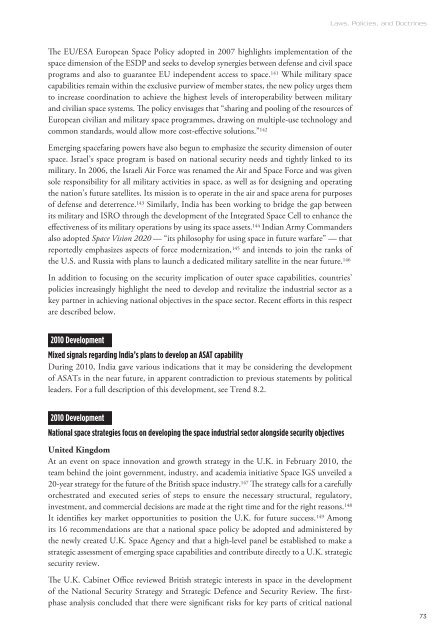Space Security Index
Space Security Index
Space Security Index
You also want an ePaper? Increase the reach of your titles
YUMPU automatically turns print PDFs into web optimized ePapers that Google loves.
e EU/ESA European <strong>Space</strong> Policy adopted in 2007 highlights implementation of the<br />
space dimension of the ESDP and seeks to develop synergies between defense and civil space<br />
programs and also to guarantee EU independent access to space. 141 While military space<br />
capabilities remain within the exclusive purview of member states, the new policy urges them<br />
to increase coordination to achieve the highest levels of interoperability between military<br />
and civilian space systems. e policy envisages that “sharing and pooling of the resources of<br />
European civilian and military space programmes, drawing on multiple-use technology and<br />
common standards, would allow more cost-eective solutions.” 142<br />
Emerging spacefaring powers have also begun to emphasize the security dimension of outer<br />
space. Israel’s space program is based on national security needs and tightly linked to its<br />
military. In 2006, the Israeli Air Force was renamed the Air and <strong>Space</strong> Force and was given<br />
sole responsibility for all military activities in space, as well as for designing and operating<br />
the nation’s future satellites. Its mission is to operate in the air and space arena for purposes<br />
of defense and deterrence. 143 Similarly, India has been working to bridge the gap between<br />
its military and ISRO through the development of the Integrated <strong>Space</strong> Cell to enhance the<br />
eectiveness of its military operations by using its space assets. 144 Indian Army Commanders<br />
also adopted <strong>Space</strong> Vision 2020 — “its philosophy for using space in future warfare” — that<br />
reportedly emphasizes aspects of force modernization, 145 and intends to join the ranks of<br />
the U.S. and Russia with plans to launch a dedicated military satellite in the near future. 146<br />
In addition to focusing on the security implication of outer space capabilities, countries’<br />
policies increasingly highlight the need to develop and revitalize the industrial sector as a<br />
key partner in achieving national objectives in the space sector. Recent eorts in this respect<br />
are described below.<br />
2010 Development<br />
Mixed signals regarding India’s plans to develop an ASAT capability<br />
During 2010, India gave various indications that it may be considering the development<br />
of ASATs in the near future, in apparent contradiction to previous statements by political<br />
leaders. For a full description of this development, see Trend 8.2.<br />
2010 Development<br />
National space strategies focus on developing the space industrial sector alongside security objectives<br />
United Kingdom<br />
At an event on space innovation and growth strategy in the U.K. in February 2010, the<br />
team behind the joint government, industry, and academia initiative <strong>Space</strong> IGS unveiled a<br />
20-year strategy for the future of the British space industry. 147 e strategy calls for a carefully<br />
orchestrated and executed series of steps to ensure the necessary structural, regulatory,<br />
investment, and commercial decisions are made at the right time and for the right reasons. 148<br />
It identies key market opportunities to position the U.K. for future success. 149 Among<br />
its 16 recommendations are that a national space policy be adopted and administered by<br />
the newly created U.K. <strong>Space</strong> Agency and that a high-level panel be established to make a<br />
strategic assessment of emerging space capabilities and contribute directly to a U.K. strategic<br />
security review.<br />
e U.K. Cabinet Oce reviewed British strategic interests in space in the development<br />
of the National <strong>Security</strong> Strategy and Strategic Defence and <strong>Security</strong> Review. e rstphase<br />
analysis concluded that there were signicant risks for key parts of critical national<br />
Laws, Policies, and Doctrines<br />
73

















